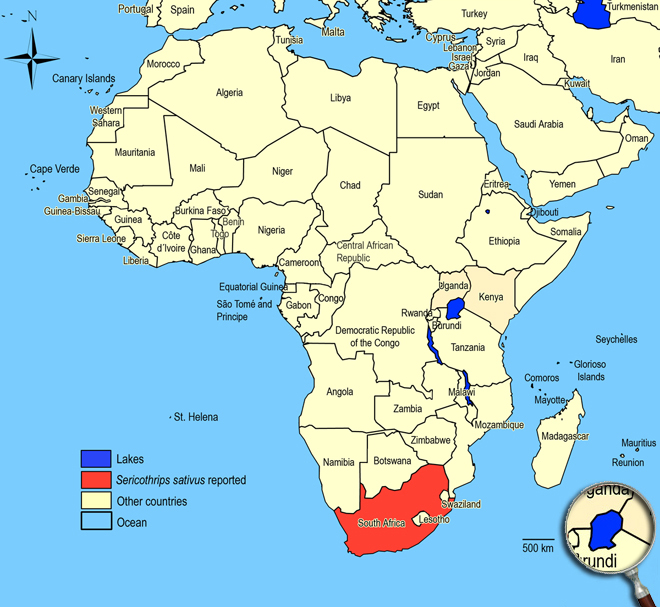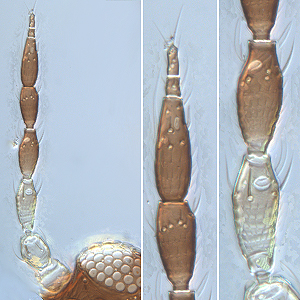Sericothrips sativus Hartwig, 1952
Sericothripinae, Thripidae, Terebrantia, Thysanoptera
Figures
Fig. 1: 8-segmented antenna, terminal segments V-VIII, segments III and IV with forked sense cone
Fig. 2: Head and pronotum
Fig. 3: Head dorsal with ocellar triangle
Fig. 4: Pronotum
Fig. 5: Meso- and metanotum
Fig. 6: Meso- and metasternal furca
Fig. 7: Meso- and metasternum
Fig. 8: Meso- and metanotum with brachypterous wings
Fig. 9: Tergites I-V
Fig. 10: Tergites V-VII
Fig. 11: Tergites VII-XI
Introduction and Recognition
Sericothrips sativus causes damage on leaves of forage plants alfalfa and red clover (Fabaceae). Female macropterous or micropterous. Body bicolored; brown with abdominal segments 3-6 yellow, also pronotum with pronotal blotch and posterior of head; fore femora, apices of tibiae and tarsi yellow, also antennal segments I-III; fore wings grey brown with sub-basal pale band. Antennae 8-segmented; segments III & IV with sense cone forked, VI with base of sense cone slightly elongate (Fig. 1). Head wider than long; postocular region with weakly transverse reticulation; ocellar triangle finely reticulate; 3 pairs of ocellar setae, pair III arise on anterior margins of ocellar triangle; 3 pairs of postocular setae, median pair long (Fig. 2 and 3). Pronotum, including pale pronotal blotch, uniformly fine and closely transverse striate; 1 pair of moderately long setae near posterior angles (Fig. 4). Meso- and metafurca with stout median spinula; meso- and metanotum sculpture mainly transverse striate. Metanotum with median setae arise well behind anterior margin or medially; without campaniform sensilla; metasternum with a transverse line along anterior margin; metascutellum with bands of microtrichia medially (Fig. 5). Mid- and hind tarsi 2-segmented. Fore wing first vein distinct from costal vein and with continuous row of setae; second vein without or with 1 seta near apex (Fig. 8). Tergites I-VIII uniformly and densely covered with microtrichia, with complete posteromarginal comb of long and irregular microtrichia, and with median pair of setae similarly placed and of equal size; median setal pair of tergites II-VII shorter than distance between their bases (Fig. 9-11). Sternites without discal setae but fully covered with rows of microtrichia; sternites III-VII with lobed posteromarginal craspedum bearing long microtrichia between the marginal setae; sternite VII posteromarginal setae S1 arising in front of margin. Micropterous female with wing lobe shorter than width of thorax.
Male micropterous; similar to female, but tergite VII yellow.
Taxonomic Identity
Species
Sericothrips sativus Hartwig, 1952
Taxonomic history
-
Common name
-
Present taxonomic position
Family: Thripidae Stephens, 1829
Subfamily: Sericothripinae Karny, 1921
Genus: Sericothrips Haliday, 1836
Genus description
The genus Sericothrips Haliday, 1836
Sericothrips comprises 9 species, 8 of these holarctic, Sericothrips sativus from South Africa. It is a member of the subfamily Sericothripinae, closely related to the genus Neohydatothrips and Hydatothrips. These thrips all have numerous closely spaced rows of microtrichia on the lateral thirds of the tergites, fore wings with a complete row of setae on the first vein whereas on the second vein there are 0 or only 2 setae. Most of them have a remarkably elongate base to the sense cone on the sixth antennal segment and a distinctive colored and/or sculptured area on the pronotum, the pronotal blotch. Bhatti (1973) has given identification keys to distinguish the various genera involved. All of the species of Sericothrips have the tergites completely covered with microtrichia, also medially, and with a complete posteromarginal comb of long microtrichia, and the metasternum has a transverse line along anterior margin.
Species description
Typical key character states of Sericothrips sativus
Coloration and body sculpture
Body color: distinctively bicolored
Surface of head, pronotum and fore legs: without obvious or with weakly reticulate sculpture
Antennae
Form of sense cones on antennal segments III and IV: emergent and forked on segments III and IV
Number of antennal segments: 8
Head
Distance between bases of ocellar setae III: greater than width of first ocellus
Ocellar setae I: present
Ocellar setae III: arising on anterior margin of, or in front of ocellar triangle
Ocelli: present
Prothorax
Pronotal blotch or internal apodeme: present
Pronotum shape: broadly rectangular
Pronotum surface: with transverse striate sculpture
Pronotal blotch: pale
Mesothorax
Mesosternal furca: with median spinula
Metathorax
Metanotum with dominant sculptured triangle medially: absent
Metasternal furca: with spinula
Metasternum anterior margin: almost transverse
Sculpture of metanotum median area: transversally striate
Shape of metathoracic furca: transverse, V-shaped
Metascutellum: with bands of microtrichia medially
Wings
Fore and hind wings: present, more than half as long as abdomen (macropterous) or absent, or not longer than thorax width
Fringe cilia arising: from sockets
Fore wing veins: present
Fore- and hind wing surface: covered with microtrichia
Apex of fore wing: with prominent terminal setae
Fore wing costal fringe cilia: arising at anterior margin of wing
Fore wing first vein: distinct from costal vein
Fore wing first vein setal row: complete, with setae closely and uniformly spaced
Fore wing second vein setal row: with no setae
Fore wing shape: mainly parallel sided or margins run continuously towards each other
Fore wing surface: not reticulate
Shape of fore wing apex: with mainly posterior margin curved to join anterior margin
Fore wings: uniformly dark or shaded, but with base or sub-base pale
Legs
Mid and hind tarsi: with two segments
Abdomen
Sternites V and VI microtrichia: extending fully across discal area
Sternite VII median posteromarginal setae S1: arising in front of posterior margin
Microtrichia on tergites II to VII: completely covered
Median setal pairs on tergites II to VII: similar in size and position
Tergites IV and V median setal pair: shorter than distance between their bases
Markings on tergites IV to VI: without shaded areas medially
Tergite VIII ctenidia: without paired ctenidia laterally, sometimes with irregular microtrichia
Tergite VIII posteromarginal comb of microtrichia: present and complete medially
Tergite VIII shape of posteromarginal microtrichia: long, slender and irregular
Surface of lateral thirds of abdominal tergites: with many regular rows of fine microtrichia
Tergite X: not tubular, longitudinally incomplete

Similar or related species
Sericothrips sativus is closely related to Hydatothrips adolfifriderici and Neohydatothrips samayunkur. Compared to these both species, Sericothrips sativus has a pale pronotal blotch, and the metanotal median area sculptured lines are transverse striate. In Hydatothrips adolfifriderici the dark pronotal blotch is not emarginate posteriorly, and metanotal median area sculptured lines are transverse at anterior, but forming irregular longitudinal reticulations on posterior half. In Neohydatothrips samayunkur the dark pronotal blotch is deeply emarginate posteriorly, and metanotal median area sculptured lines are also transverse at anterior, but longitudinal and parallel on posterior half. Sericothrips sativus as well as Neohydatothrips samayunkur have the metasternum anterior margin almost transverse, whereas in Hydatothrips adolfifriderici the metasternum has an anterior margin deeply U-shaped with median V-shaped apodem. Furthermore, Sericothrips sativus differs from both related species by the metascutellum covered with bands of microtrichia medially, tergites I-VIII completely covered with microtrichia, and have a complete posteromarginal comb of microtrichia, the tergal median setae are similarly placed and of equal size, and the median setal pair is shorter than distance between their bases. Whereas Hydatothrips adolfifriderici as well as Neohydatothrips samayunkur have no microtrichia on metascutellum, dense microtrichia on tergites I-VIII only on lateral thirds and median area smooth or with sparse microtrichia, tergites I-VI posteromarginal comb of microtrichia is present laterally but incomplete medially, median setae are short on tergites I-IV and longer on V-VIII, median setal pair longer than distance between their bases.
Biology
Life history
As with other thrips species the life cycle from egg to adult is dependent on temperature. The full cycle can take about 15 days (Lewis 1973) to over a month and adults may live for more than one month producing several generations in one year depending on seasonal weather. With greenhouse temperatures the developmental time from egg to adult can decrease to about one week.
Host plants
Fabaceae: alfalfa, red clover (Trifolium pratense).
Vector capacity
None identified, but possible mechanical distribution of phytopathogenic fungi and bacteria.
Damage and symptoms
-
Detection and control strategies
-
Additional notes
Feeding and breeding on leaves.
Biogeography
South Africa (Gauteng: Pretoria; Free State: Glen; Northern Cape: Kimberley, Douglas, Sutherland).
African countries where Sericothrips sativus has been reported

The species Sericothrips sativus was not observed in surveys undertaken in East Africa on vegetables and associated weeds and crops.
Please click here for survey sites of all observed thrips species of Kenya, Tanzania and Uganda.

Bibliography
Bhatti JS (1973). A preliminary revision of Sericothrips Haliday, sensu lat., and related genera, with a revised concept of the tribe Sericothripini (Thysanoptera: Thripidae). Oriental Insects. 7 (3): 403-449
Hartwig EK (1952). Taxonomic studies of South African Thysanoptera, including genitalia, statistics and a revision of Trybom's types. Entomology Memoirs. 2 (11): 340-499
Lewis T (1973). Thrips: their biology, ecology and economic importance. Academic Press Inc., London Ltd., 349 pp
zur Strassen R (1960). Catalogue of the known species of South African Thysanoptera. Journal of the Entomological Society of Southern Africa. 23 (2): 321-367
----
Web links
Mound´s Thysanoptera pages
Thysanoptera Checklist
ICIPE Thrips survey sites
UNI Halle & Thrips sites
Thrips of California














